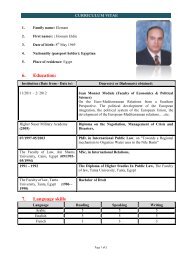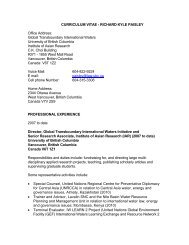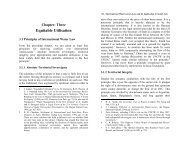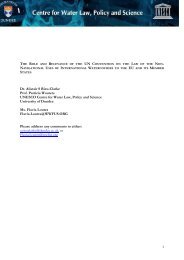Upreti, Trilochan, International Watercourses Law and Its Application ...
Upreti, Trilochan, International Watercourses Law and Its Application ...
Upreti, Trilochan, International Watercourses Law and Its Application ...
Create successful ePaper yourself
Turn your PDF publications into a flip-book with our unique Google optimized e-Paper software.
Legality River Linking Project / 265 266 / <strong>International</strong> <strong>Watercourses</strong> <strong>Law</strong> <strong>and</strong> <strong>Its</strong> <strong>Application</strong> in South Asiause such resources, but these rules could be applicabledifferently in different situations. 11 The main theme of the lawis that international watercourses should be shared in areasonable, sustainable <strong>and</strong> equitable manner <strong>and</strong> Article 6provides seventeen considerations to be applied for sharingsuch resources in such circumstances. 12 Furthermore, equalweights have been given to all elements, which means that nosingle consideration outweighs the others. However, Article 10provides that the vital human needs, supposedly drinking use,will get the top priority over other uses. Consideration of theprocedural underpinnings requires a co-riparian state to givenotice <strong>and</strong> information together with the copies of such plans<strong>and</strong> studies contemplated over international watercourses inorder to obtain the consent of the neighbours that would beaffected by such an undertaking. If such consent is notforthcoming <strong>and</strong> objections are raised by riparian states,negotiation for achieving consent would be required. Thisprocess itself is very complex <strong>and</strong> could take years to completethe exercise.In the contextual situation of the Brahmaputra or the Gangesriver, if the drinking water needs of Bangladesh were to beimpeded by any irrigation <strong>and</strong> other uses in Indian territory, theformer use must of necessity get top priority <strong>and</strong> the latter usescannot be justified as reasonable <strong>and</strong> equitable. In anotherinstance, if the RLP conceived by India could hamper theexisting irrigation, drinking water, navigational <strong>and</strong> other usesof Bangladesh, such work would be considered inequitable <strong>and</strong>unreasonable. Similar provisions would be applicable to each ofthe riparian states of south Asia from the proposed RLP. That isto say, the RLP should not inflict any harm or injury to otherriparian states such as Bhutan, Nepal <strong>and</strong> Bangladesh. It isobvious that the anticipated repercussions of the project wouldgo contrary to this principle. In other words, there would11 36 ILM (1997), pp. 700-720.12 Ibid.naturally arise hindrances, injury or harm in one way or other tothe upstream <strong>and</strong> downstream riparian states.For instance, the implementation of the RLP would necessitatethe construction of several high dams <strong>and</strong> structures in Nepal,Bhutan, <strong>and</strong> India, which could be harmful for the environmentincluding aquatic life, not to mention the highly sensitiveattendant problems of the resettlement <strong>and</strong> rehabilitation ofmillions of people. Furthermore, such structures woulddecimate huge tracts of forests with all their biodiversity,national parks <strong>and</strong> sanctuaries, religious sites, <strong>and</strong> adverselyaffect the livelihoods of ethnic people. According to SureshPrabhu, past Indian record on rehabilitation is deplorable. 13 Thecases of other south Asian countries have worsening record.The drastic alteration in the existing hydrology <strong>and</strong> climaticconditions could engender an environmental disaster. These aresome of the anticipated inevitable consequences of theproposed project. How India's neighbours would be benefitedor compensated for such inevitabilities, or what would be thestatus of the existing treaty regime <strong>and</strong> how they would bereplaced with a new treaty regime are very staggering <strong>and</strong>intricate issues. It would be a very tricky, complex <strong>and</strong>protracted process to negotiate <strong>and</strong> finalise a treaty in thisconnection. In a milieu of democratic dispensation wherevehement arguments for <strong>and</strong> against mammoth water resourceprojects have a right to be heeded, all stakeholders- affectedstates, people, civil societies, NGOs, experts, political parties<strong>and</strong> diverse interest groups- must be provided the opportunityto voice their concerns. Hitherto, such a process has beentaking place in India <strong>and</strong>, in a few instances, in Bangladesh. Itis understood that Nepal <strong>and</strong> Bhutan have not even bothered toinitiate such a discussion yet at any appreciable level.It is germane to shed some light on the outcome of suchexercises held in India in this highly charged context. It is13 Supra note 1.












